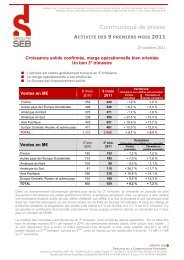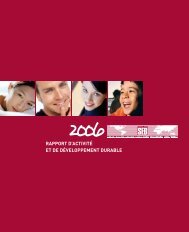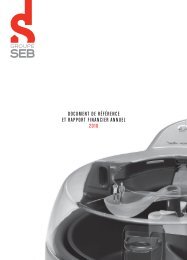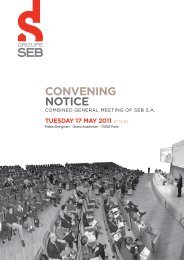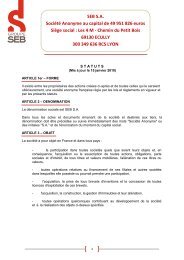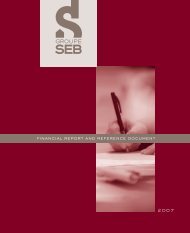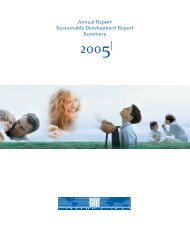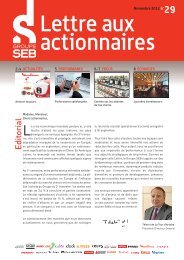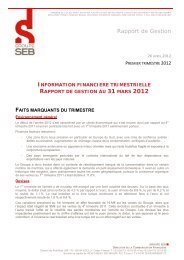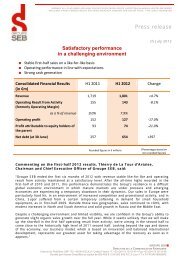financial report and registration document 2011 - Groupe SEB
financial report and registration document 2011 - Groupe SEB
financial report and registration document 2011 - Groupe SEB
Create successful ePaper yourself
Turn your PDF publications into a flip-book with our unique Google optimized e-Paper software.
5 Notes<br />
Consolidated fi nancial statements<br />
to the consolidated fi nancial statements<br />
<strong>and</strong> (iv) introduce new disclosure requirements. The amended IAS 19 will<br />
be applicable on a retrospective basis from 1 January 2013.<br />
Note 1.1. BASIS AND SCOPE<br />
OF CONSOLIDATION<br />
Material companies that are exclusively controlled by <strong>SEB</strong> S.A. either directly<br />
or indirectly are fully consolidated.<br />
The profi ts of subsidiaries acquired or disposed of during the year are<br />
recognised in the consolidated income statement from the acquisition date<br />
or up to the disposal date.<br />
Where necessary, the fi nancial statements of subsidiaries are restated to<br />
comply with Group accounting policies.<br />
Material companies over which <strong>SEB</strong> S.A. exercises signifi cant infl uence,<br />
directly or indirectly, are accounted for by the equity method. At 31 December<br />
<strong>2011</strong>, no entities were accounted for by the equity method.<br />
Certain companies fulfi lling the above criteria are not consolidated because<br />
they are not material in relation to the Group as a whole. The materiality<br />
criteria applied by the Group are as follows:<br />
� revenue of at least €10 million;<br />
� total assets of at least €10 million;<br />
� total debt of at least €5 million.<br />
The list of consolidated companies is presented in Note 32.<br />
All material intra-group transactions have been eliminated in consolidation.<br />
Note 1.2. FOREIGN CURRENCY TRANSLATION<br />
1.2.1. Translation of the fi nancial statements<br />
of foreign operations<br />
The fi nancial statements of foreign entities are prepared in their functional<br />
currency, corresponding to the currency of the primary economic environment<br />
in which the entity operates. The functional currency of most foreign entities<br />
is their local currency.<br />
The euro is the Group’s functional currency <strong>and</strong> <strong>report</strong>ing currency.<br />
The fi nancial statements of foreign entities are translated into euros by the<br />
closing rate method, as follows;<br />
� assets <strong>and</strong> liabilities in a functional currency other than the euro are<br />
translated at the closing rate at the balance sheet date <strong>and</strong> income<br />
statement items are translated at the weighted average rate for the year;<br />
� the resulting exchange differences are recognised as a separate<br />
component of equity, under “Translation reserve”.<br />
The fi nancial statements of subsidiaries whose functional currency is not the<br />
local accounting currency are initially translated into the functional currency<br />
using the historical rate method, as follows:<br />
� non-monetary assets <strong>and</strong> liabilities (non-current assets, inventories <strong>and</strong><br />
securities) <strong>and</strong> the corresponding movements recorded in the income<br />
statement are translated at the historical exchange rate;<br />
� monetary assets <strong>and</strong> liabilities (cash, short <strong>and</strong> long-term loans <strong>and</strong><br />
borrowings, <strong>and</strong> operating receivables <strong>and</strong> payables) are translated at<br />
the closing rate at the balance sheet date;<br />
� income statement items are translated at the weighted average rate for<br />
the year, apart from depreciation, amortisation <strong>and</strong> impairment losses on<br />
non-monetary items;<br />
� the resulting exchange differences are recognised in the income statement.<br />
These fi nancial statements in the functional currency are then translated into<br />
euros using the closing rate method.<br />
In accordance with the option available to fi rst-time adopters under IFRS 1,<br />
<strong>Groupe</strong> <strong>SEB</strong> elected to reset to zero at 1 January 2004 the cumulative<br />
translation differences arising on consolidation of foreign entities.<br />
1.2.2. Translation of foreign currency transactions<br />
Foreign currency transactions are recognised <strong>and</strong> measured in accordance<br />
with IAS 21 – The Effects of Changes in Foreign Exchange Rates.<br />
Transactions in currencies other than the euro are initially recognised at<br />
the exchange rate prevailing on the transaction date. Monetary assets <strong>and</strong><br />
liabilities in currencies other than the euro are translated at the closing<br />
exchange rate, <strong>and</strong> the resulting exchange differences are recognised in<br />
the income statement.<br />
The effect of changes in exchange rates on the fair value of non-monetary<br />
fi nancial assets <strong>and</strong> liabilities is recognised by the accounting method<br />
applied to the category of fi nancial assets or liabilities concerned.<br />
Monetary fi nancial assets are measured at amortised cost in the original<br />
currency <strong>and</strong> changes in amortised cost corresponding to exchange<br />
differences are recognised in the income statement, while other changes<br />
are recognised directly in equity.<br />
The Group’s exposure to certain currency risks is hedged using forward<br />
purchase agreements <strong>and</strong> options (see below accounting methods applicable<br />
to derivative fi nancial instruments).<br />
Note 1.3. USE OF ESTIMATES<br />
The preparation of consolidated fi nancial statements in accordance with<br />
IFRS requires the use of estimates <strong>and</strong> assumptions that have an impact<br />
on the <strong>report</strong>ed amounts of assets <strong>and</strong> liabilities – such as accumulated<br />
depreciation, amortisation <strong>and</strong> impairment losses – <strong>and</strong> contingent assets<br />
<strong>and</strong> liabilities at the balance sheet date, <strong>and</strong> income <strong>and</strong> expenses for the<br />
year.<br />
All such estimates are made on a going concern basis using the information<br />
available when the fi nancial statements are drawn up. They refl ect amounts<br />
<strong>and</strong> assumptions that management considers relevant <strong>and</strong> reasonable given<br />
the Group’s operating environment <strong>and</strong> past experience. In the current<br />
economic environment, short <strong>and</strong> medium-term forecasting has become<br />
more diffi cult. The estimates <strong>and</strong> assumptions used to prepare the <strong>2011</strong><br />
consolidated fi nancial statements refl ected the fi nancial parameters shaping<br />
the market at 31 December. The value of certain assets, such as goodwill<br />
<strong>and</strong> trademarks, was estimated at the year-end based on the long-term<br />
economic outlook <strong>and</strong> management’s best estimates, taking into account<br />
the reduced visibility of future cash fl ows.<br />
84 GROUPE <strong>SEB</strong> Financial Report <strong>and</strong> Registration Document <strong>2011</strong>



